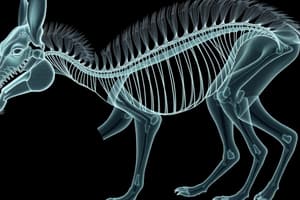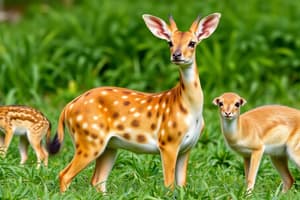Podcast
Questions and Answers
Which of the following is the broadest category in the hierarchy of animal classification?
Which of the following is the broadest category in the hierarchy of animal classification?
- Domain (correct)
- Kingdom
- Phylum
- Genus
The Linnaean system of classification is based on the evolutionary relationships of organisms.
The Linnaean system of classification is based on the evolutionary relationships of organisms.
False (B)
What is the most specific classification category in the hierarchy of animal classification?
What is the most specific classification category in the hierarchy of animal classification?
Species
The two-part naming system for species is known as __________.
The two-part naming system for species is known as __________.
Match the following classification levels with their examples:
Match the following classification levels with their examples:
Which classification uses genetic information for categorization?
Which classification uses genetic information for categorization?
Taxonomy and systematics are the same field of study.
Taxonomy and systematics are the same field of study.
Name one importance of animal classification.
Name one importance of animal classification.
Which of the following accurately describes a characteristic of the phylum Arthropoda?
Which of the following accurately describes a characteristic of the phylum Arthropoda?
Which level of classification directly follows Kingdom in the taxonomic hierarchy?
Which level of classification directly follows Kingdom in the taxonomic hierarchy?
In the context of binomial nomenclature, which of the following represents the correct format for naming a species?
In the context of binomial nomenclature, which of the following represents the correct format for naming a species?
What distinguishes the phylum Chordata from other animal phyla?
What distinguishes the phylum Chordata from other animal phyla?
Which classification method is primarily based on common ancestry and shared derived characteristics?
Which classification method is primarily based on common ancestry and shared derived characteristics?
How does molecular phylogenetics contribute to animal classification?
How does molecular phylogenetics contribute to animal classification?
Which of the following is NOT a function of animal classification?
Which of the following is NOT a function of animal classification?
Which characteristic is used to differentiate between species within the same genus?
Which characteristic is used to differentiate between species within the same genus?
Flashcards are hidden until you start studying
Study Notes
Animal Classification
-
Definition: The systematic categorization of animals based on shared characteristics and evolutionary relationships.
-
Hierarchy of Classification:
- Domain: Broadest category; includes all living organisms.
- Eukarya (organisms with complex cells, including animals).
- Kingdom: Major category; for animals, this is Animalia.
- Phylum: Groups based on major body plans; examples:
- Chordata (vertebrates and some invertebrates).
- Arthropoda (insects, arachnids, crustaceans).
- Class: Further division within phyla; examples:
- Mammalia (mammals).
- Aves (birds).
- Reptilia (reptiles).
- Order: More specific grouping; examples:
- Carnivora (carnivorous mammals).
- Primates (monkeys, apes, and humans).
- Family: Even narrower classification; examples:
- Felidae (cats).
- Hominidae (great apes and humans).
- Genus: Groups species that are closely related; examples:
- Panthera (big cats like lions and tigers).
- Homo (humans).
- Species: Most specific classification; represents individual organisms capable of interbreeding; examples:
- Panthera leo (lion).
- Homo sapiens (human).
- Domain: Broadest category; includes all living organisms.
-
Types of Classification Systems:
- Linnaean System: Traditional hierarchical approach named after Carl Linnaeus.
- Phylogenetic Classification: Based on evolutionary relationships and genetic data; represented in tree diagrams.
-
Key Concepts:
- Binomial Nomenclature: Two-part naming system for species (Genus species), e.g., Homo sapiens.
- Taxonomy vs. Systematics: Taxonomy is the science of naming and classifying organisms, while systematics focuses on understanding evolutionary relationships.
- Morphological vs. Molecular Classification: Morphological uses physical traits for classification, while molecular uses genetic information.
-
Importance of Classification:
- Organizes biological diversity.
- Aids in identification and study of species.
- Facilitates biological research and conservation efforts.
- Helps understand evolutionary history and relationships among organisms.
Animal Classification Overview
- Systematic categorization of animals based on shared traits and evolutionary ties.
Hierarchy of Classification
- Domain: Broadest category encompassing all living organisms; includes Eukarya, which has complex cells.
- Kingdom: Major grouping for animals known as Animalia.
- Phylum: Divided by significant body plans, with examples including:
- Chordata: Vertebrates and some invertebrates.
- Arthropoda: Insects, arachnids, and crustaceans.
- Class: Subdivisions within phyla, examples include:
- Mammalia: Mammals.
- Aves: Birds.
- Reptilia: Reptiles.
- Order: More specific groupings, including:
- Carnivora: Carnivorous mammals.
- Primates: Monkeys, apes, and humans.
- Family: Narrow classifications, such as:
- Felidae: Cats.
- Hominidae: Great apes and humans.
- Genus: Groups closely related species, examples:
- Panthera: Big cats, including lions and tigers.
- Homo: Humans.
- Species: Most specific classification, capable of interbreeding. Examples include:
- Panthera leo: Lion.
- Homo sapiens: Human.
Types of Classification Systems
- Linnaean System: Traditional hierarchy created by Carl Linnaeus.
- Phylogenetic Classification: Based on evolutionary relationships, represented through tree diagrams.
Key Concepts
- Binomial Nomenclature: Two-part naming method (Genus species), exemplified by Homo sapiens.
- Taxonomy vs. Systematics:
- Taxonomy: Science of naming and classifying organisms.
- Systematics: Focuses on understanding evolutionary relationships.
- Morphological vs. Molecular Classification:
- Morphological: Uses physical traits for classification.
- Molecular: Utilizes genetic information for classification.
Importance of Classification
- Organizes biological diversity for better understanding.
- Assists in species identification and research.
- Facilitates biological conservation efforts.
- Enhances comprehension of evolutionary history and interrelations between organisms.
Animal Classification Overview
- Systematic categorization of animals based on shared characteristics and evolutionary relationships.
Levels of Classification
- Domain: Eukarya, encompassing organisms with eukaryotic cells.
- Kingdom: Animalia, composed of multicellular, heterotrophic organisms.
- Phylum: Major groups determined by body plan and structure, including Chordata (vertebrates) and Arthropoda (insects and arachnids).
- Class: Subdivisions within phyla, such as Mammalia (mammals) and Aves (birds).
- Order: Classification within classes, e.g., Carnivora (carnivores) and Primates (primates).
- Family: Divisions of orders, like Felidae (cats) and Hominidae (great apes).
- Genus: Groups of closely related species, e.g., Panthera (big cats) and Homo (humans).
- Species: Basic classification unit; a group capable of interbreeding, e.g., Panthera leo (lion) and Homo sapiens (human).
Taxonomic Hierarchy
- Each classification level is referred to as a taxon (plural: taxa).
- Hierarchical structure enables precise organization and identification of species.
Binomial Nomenclature
- Developed by Carl Linnaeus, utilizes a two-name system (Genus + Species) for species identification.
- Format: Genus is capitalized, species is lowercase; both are italicized or underlined (e.g., Felis catus for domestic cat).
Major Animal Phyla
- Porifera: Sponges with simple, porous structures.
- Cnidaria: Includes jellyfish and corals, characterized by stinging cells called nematocysts.
- Platyhelminthes: Flatworms exhibiting bilateral symmetry, lacking a body cavity.
- Nematoda: Roundworms noted for their cylindrical and non-segmented bodies.
- Mollusca: Soft-bodied animals, often with shells, such as snails and octopuses.
- Annelida: Segmented worms featuring a true coelom and segmentation.
- Arthropoda: Largest phylum; includes insects and arachnids, characterized by exoskeletons and jointed limbs.
- Chordata: Phylum of animals possessing a notochord, which includes all vertebrates.
Evolutionary Relationships
- Classification is reflective of phylogeny, which is the evolutionary history of organisms.
- Cladistics: Classification method focused on common ancestry and shared derived traits.
Modern Techniques in Classification
- DNA sequencing and molecular phylogenetics are employed to clarify evolutionary relationships among species.
- Integrates data from genetics, morphology, and ecology for comprehensive animal classification.
Importance of Animal Classification
- Supports biodiversity conservation and enhances ecological understanding.
- Facilitates knowledge sharing and communication among scientists and researchers globally.
Studying That Suits You
Use AI to generate personalized quizzes and flashcards to suit your learning preferences.




